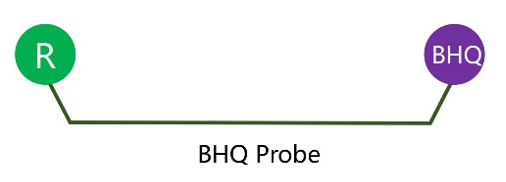BHQ Probes
The BHQ quenchers include BHQ-0 (430–520 nm), BHQ-1 (480–580 nm), BHQ-2 (550–650 nm), and BHQ-3 (620–730 nm). These non-fluorescent quenchers efficiently absorb fluorescence emitted by reporter dyes within their respective spectral ranges. With a broad absorption spectrum spanning from 430 nm to the near-infrared region, BHQ quenchers provide strong quenching efficiency, effectively reducing background noise and thereby enhancing the signal-to-noise ratio. Ideal for multiplex qPCR applications.

BHQ-X Probe
BHQ-X probes are optimized versions of traditional TaqMan probes. They feature a 3' end conjugated with BHQ-X, a minor groove binder that increases the probe’s melting temperature (by approximately 10 °C) and stabilizes hybridization with the target. This allows BHQ-X probes shorter than conventional probes while offering improved specificity. Additionally, BHQ-X probes incorporate a non-fluorescent quencher (NFQ) that effectively quenches the signal from the reporter dye at the 5' end, reducing background fluorescence and enhancing detection sensitivity. Recommended for SNP detection.

TAMRA Probe
TAMRA was one of the first quenchers used in TaqMan probe technology. Although it was widely used in early designs, its fluorescent properties result in higher background signals and limited spectral compatibility, making it less suitable for qPCR applications.

Molecular Beacon Probe
Molecular beacons are probes capable of forming a stem-loop (hairpin) structure. The 5′ end is labeled with a fluorescent reporter and a quencher (typically Dabcyl) at the 3′ end. The loop region is complementary to the target sequence, while the stem is formed by complementary sequences at both ends of the probe. During the annealing process, the probe hybridizes with the target, separating the fluorophore from the quencher and generating a fluorescent signal. The unique hairpin design makes molecular beacons exceptionally specific in distinguishing target sequences, ideal for real-time PCR, SNP detection, and mutation analysis.




